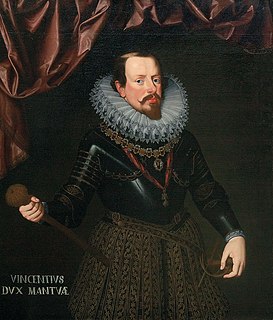Related Research Articles
The year 1607 in music involved some significant events.

Girolamo Alessandro Frescobaldi was an Italian composer and virtuoso keyboard player. Born in the Duchy of Ferrara, he was one of the most important composers of keyboard music in the late Renaissance and early Baroque periods. A child prodigy, Frescobaldi studied under Luzzasco Luzzaschi in Ferrara, but was influenced by many composers, including Ascanio Mayone, Giovanni Maria Trabaci, and Claudio Merulo. Girolamo Frescobaldi was appointed organist of St. Peter's Basilica, a focal point of power for the Cappella Giulia, from 21 July 1608 until 1628 and again from 1634 until his death.
Giovanni Bassano was an Italian composer associated with the Venetian School of composers and a cornettist of the late Renaissance and early Baroque eras. He was a key figure in the development of the instrumental ensemble at the basilica of San Marco di Venezia. His detailed book on instrumental ornamentation has survived. It is a rich resource for research in contemporary performance practice. Bassano was most responsible for the performance of the music of Giovanni Gabrieli, who would emerge as one of the most renowned members of the Venetian School.

Vincenzo Ι Gonzaga was ruler of the Duchy of Mantua and the Duchy of Montferrat from 1587 to 1612.

Guglielmo Gonzaga was Duke of Mantua from 1550 to 1587, and of Montferrat from 1574 to 1587. He was the second son of Federico II Gonzaga, Duke of Mantua and Margaret Palaeologina of Montferrat. In 1574, Montferrat was elevated to a Duchy and Guglielmo became its first duke. He was succeeded as Duke of both duchies by his son Vincenzo.
Giorgio Pacchioni is an Italian performer, professor, and composer.
Giovanni Girolamo Kapsperger was an Austrian-Italian virtuoso performer and composer of the early Baroque period. A prolific and highly original composer, Kapsberger is chiefly remembered today for his lute and theorbo (chitarrone) music, which was seminal in the development of these as solo instruments.
The year 1610 in music involved some significant events.
The year 1614 in music involved some significant musical events.
The year 1612 in music involved some significant events.
The year 1603 in music involved some significant events.
Girolamo (Hieronimo) Cavazzoni was an Italian organist and composer, son of Marco Antonio Cavazzoni. Little is known about his life except that he worked at Venice and Mantua, and published two collections of organ music. These collections only contain music written before about 1549, but are of high quality, and established the traditional form of imitative ricercars and canzonas.
Giovanni Battista Grillo was an Italian composer and organist.
Francesco Rovigo was an Italian composer and organist of the late Renaissance, active in Mantua and Graz.
Costanzo Antegnati was an organist, organ builder and composer.

The Basilika Palatina di Santa Barbara is the Palatine Chapel of the House of Gonzaga in Mantua, Italy.
Francesco Beretta was an Italian organist, composer and Kapellmeister and a predecessor of Paolo Lorenzani - a pupil of Orazio Benevoli - at the Cappella Giulia of St. Peter.
References
- 1 2 3 Bridges, Thomas W. (2001). "Trofeo [De Troffeis], Ruggier". Grove Music Online. doi:10.1093/gmo/9781561592630.article.28411. ISBN 978-1-56159-263-0.
- ↑ Monteath, Kathryn Bosi. "Musica divina: sacred music for the house of Gonzaga from Guglielmo to Ferdinando" – via www.academia.edu.
{{cite journal}}: Cite journal requires|journal=(help) - 1 2 3 Greene, D.M. (1986). Greene's Biographical Encyclopedia of Composers. Collins. p. 109. ISBN 978-0-00-434363-1 . Retrieved 2022-07-18.
- ↑ Pellegrini, V.; Ladewig, J.; Lucino, F.; Corradini, N.; Lomazzo, F. (1995). Canzonas and capriccio from the Seconda aggiunta alli concerti raccolti dal molto reverendo don Francesco Lucino: a due, trè e quattro voci, di diversi eccellenti autori-- novamente raccolta & data in luce da Filippo Lomazzo : Milan, 1617. Canzonas and Capricco from the Seconda aggiunta alli concerti raccolti dal molto reverendo Don Francesco Lucino a due, trè, e quattro voci, di diversi eccellenti autori, novamente raccolta, & data in luce da Filippo Lomazzo (in Italian). Garland. p. 11. ISBN 978-0-8240-4528-9 . Retrieved 2022-07-18.
- ↑ Kendrick, R.L. (2002). The Sounds of Milan, 1585-1650. Oxford University Press. p. 104. ISBN 978-0-19-513537-4 . Retrieved 2022-07-18.
- ↑ "Archilet - Lettera". www.archilet.it.
- ↑ "Archilet - Lettera". www.archilet.it.
- ↑ "Archilet - Lettera". www.archilet.it.
- ↑ "Archilet - Lettera". www.archilet.it.